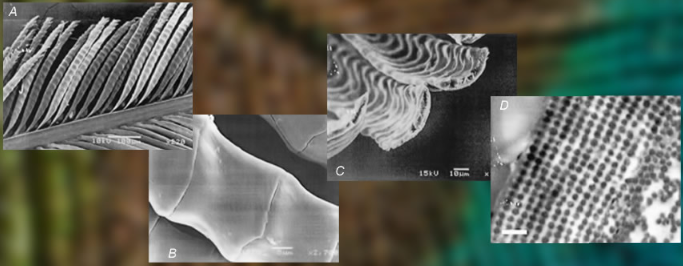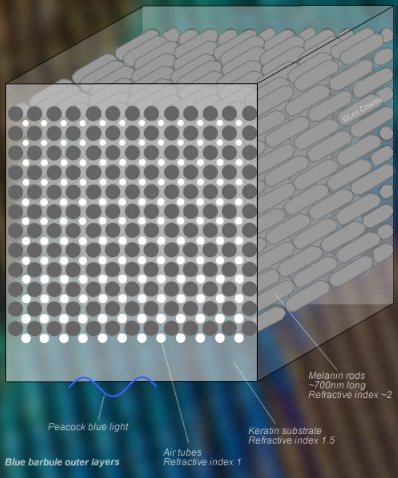OPOD - Peacocks
OPOD - Peacocks: The Intricate Beauty of Peacock Feathers Revealed
Peacock feathers have long captivated us with their stunning colors and mesmerizing patterns. The courtship fan of a peacock is a sight to behold, with its vibrant greens, blues, and subtle browns, adorned with transfixing 'eyes'. While we may attribute this visual spectacle to iridescence, the truth is that peacock feathers exhibit a different kind of optical phenomenon that is equally captivating. In this article, we will delve deeper into the intricate beauty of peacock feathers, exploring the microscopic structures that give rise to their vivid colors.
Unveiling the Microscopic Wonders
When we examine a peacock feather at higher magnification, we are able to unravel the secrets behind its enchanting colors. At first glance, the bright blue eyes of the feather appear as part of a tufted carpet pattern. Upon closer inspection, we discover that each eye is formed by a feather main stem crossing a series of barbs that project symmetrically outwards. Along each barb are rows of tiny hair-like structures called barbules, which are responsible for producing the color.
To truly appreciate the intricate details of the barbules, electron microscopy comes to our aid. Under higher magnification, we can observe a single barb with its rows of twisted barbules. These barbules possess a crescent-shaped cross-section and are densely packed on the outer skin while having looser structures within. It is within these barbules that the color generators reside.
The Marvels of Nano-Engineering
As we delve even deeper into the microscopic world of peacock feathers, we encounter the true marvels of nano-engineering. The outer layers of the barbules reveal a highly ordered rectangular array of dark circles embedded in a lighter material. Surprisingly, these colors are not derived from pigments but rather from slices through melanin rods, which measure approximately 110-130nm in diameter. To put this into perspective, the peak wavelength of peacock blue light is around 450nm, making the melanin rods significantly larger.
Transparent keratin separates the melanin rods, creating air holes that are threaded between the squares formed by the rods. This intricate arrangement forms a photonic crystal, a periodic array of changing refractive index that exhibits a band gap where certain colors of light are blocked. The blocked light is then scattered externally, giving rise to the vibrant colors we see in peacock feathers.
A Symphony of Colors
What makes peacock feathers even more fascinating is the variation in color across different regions of the feather. Regardless of the color, the rectangular lattice structure is present throughout, albeit with varying dimensions and number of layers. For example, blue and green barbules have 9-12 layers of rods, while yellow barbules have approximately 6 layers, and brown barbules have around 4 layers. The lattice spacing also changes with color, with blue feathers exhibiting the tightest lattice of rods spaced approximately 140nm between centers.
The arrangement of melanin rods within the barbules creates a diffraction grating effect. Light waves scattered by each rod interfere with one another, resulting in the display of several orders of sunlight spectra in different directions. As more rod layers are added, the interference between scattered waves becomes more complex, leaving only a relatively narrow wavelength band of color. The specific scattered color depends on the lattice spacing, further contributing to the symphony of colors observed in peacock feathers.
Beyond the Photonic Crystal
While the 2D photonic crystal formed by the melanin rods and air holes is a key factor in producing the optical effects of peacock feathers, it is not the sole contributor. The crescent shape of the barbules and the bulges along the melanin rods are believed to play additional roles in enhancing the optical properties of the feathers. The interplay of these various elements adds further complexity to the intricate beauty of peacock feathers.
Applications and Future Discoveries
The study of peacock feathers and their optical properties has not only provided us with a deeper understanding of nature's wonders but has also sparked interest in potential applications in optical engineering and communications. Researchers are exploring ways to mimic the nano-engineered structures found in peacock feathers for various technological advancements. Imagine pigment-free paints that never fade, fabrics that exhibit vibrant colors for longer periods, or even cosmetics and toothpaste that utilize photonic crystal technology for unique visual effects. The possibilities are intriguing and could potentially give rise to a whole new industry.
In conclusion, peacock feathers are not just visually stunning but also hold a wealth of scientific marvels within their seemingly simple structure. From the highly ordered arrangement of melanin rods to the intricate interplay of light waves, these feathers serve as a testament to the beauty and complexity of nature's creations. By unraveling the secrets behind peacock feathers, we gain not only a greater appreciation for their splendor but also insights that can inspire advancements in various fields of science and technology.


Peacock Feathers
A courtship fan of vivid greens and blues, subtle browns, blues, transfixing 'eyes'. Iridescence? Not really, this is not the iridescence of clouds or oily puddles or of soap bubbles. Their colours are transient, mostly pastel hued and shift with angle of eye and sun. A peacock's display is electrically bright with colours almost constant from all directions.
Let's look at the peacock at higher and higher magnification - not to steal its magic but to reveal more of it.
Top left: The bright blue eye looks part of a tufted carpet pattern. A feather main stem crosses the eye and barbs project symmetrically outwards from it. Along each barb are rows of tiny hair-like barbules and the colour source is within them.
Eyesight alone fails beyond this magnification. At Mid left electron microscopy comes to aid to show a single barb with its rows of barbules. The barbules twist along their length and have a crescent shaped cross-sections.
Slice across a barbule to find a closely packed outer skin with looser structures inside. Magnify yet more and the colour generators are finally revealed. The outer layers are a highly ordered rectangular array of dark circles embedded in lighter stuff. There are no coloured pigments
The dark circles are slices through melanin rods 110-130nm dia. In comparison the peak wavelength of peacock blue light is 450nm some 3-4X greater. The rods are separated by transparent keratin and there are are air holes threaded between squares formed by the rods. Nano-engineering.
Look at different coloured feather regions and the rectangular lattice structure is everywhere - only its dimensions and number of layers change. Blue and green barbules have 9-12 layers of rods, yellow ~6 and browns ~4. The lattice spacing changes with colour, blue has the tightest lattice of rods spaced 140nm between centres.
Lower left: A single layer of rods would form an ordinary diffraction grating. Light waves scattered by each rod would combine with constructive and destructive interference to flash several orders of sunlight spectra in different directions. Add more rod layers and the waves scattered by each rod have extra opportunity to interfere with those from others. More and more wavelengths destructively interfere leaving only a relatively narrow wavelength band (~100nm wide for 525nm blue feathers) of colour. The scattered colour depends on the lattice spacing.
The whole array of rods, melanin matrix and air holes comprises a photonic crystal. The periodic array of changing refractive index has a band gap where light is of certain colour is blocked. The blocked light is scattered externally to give us the peacock's colours.
There is much interest on mimicking these natural wonders with potential applications in optical engineering and communications. Less seriously, photonic crystal pigment-free paints would not fade, fabrics might be more vibrant, cosmetics and photonic toothpaste could support a whole new marketing industry.
The peacock's 2D photonic crystal is not the whole story. It alone does not account for all peacock feathers' optical effects. The crescent shape of the barbules likely plays a role and there are bulges along the melanin rods thought to have an optical function.
The peacock has reason for its pride.


Peacock feather at higher and higher magnification. An electron microscope sequence taken by Shinya Yoshioka & Shuichi Kinoshita.
(A) A single blue feather barb (barbs project directly from the main feather stem, not visible here). Barbules are attached to each side of the barb. The ~0.5mm long barbules generate the colour.
(B) Close-up of a barbule. It twists slightly along its length.
(C) Slice through two barbules. They are crescent shaped ~50 micron (0.05mm) across. They have dense outer layers with looser structures within.
(D) Section through the outer layers of a barbule.This is the source of the colour. There are no pigments. The dark circles are high refractive index melanin rods arranged in a carefully sized rectangular array. The rods are embedded in lower refractive index keratin. Between each square of melanin rods there is an air tube (not visible in this image).
Further reading:
Shinya Yoshioka and Shuichi Kinoshita (2002), Effect of Macroscopic Structure in Iridescent Color of the Peacock Feathers, Forma 17,169-181.
Jian Zi, J, Xindi Yu, X, Yizhou Li, Xinhua Hu, Chun Xu, Xingjun Wang, Xiaohan Liu., and Rongtang Fu, Coloration strategies in peacock feathers (2003), PNAS. 100:12576-12578
Image credits
Peacock
Les Cowley
Peacock feather close-up
Dr Erica Bower Science Writer, editor, photographer, UK - Shown with permission
Barbule electron micrographs
Professors Shuichi Kinoshita & Shinya Yoshioka
Osaka University, Japan - Shown with permission
Note: this article has been automatically converted from the old site and may not appear as intended. You can find the original article here.
Reference Atmospheric Optics
If you use any of the definitions, information, or data presented on Atmospheric Optics, please copy the link or reference below to properly credit us as the reference source. Thank you!
-
<a href="https://atoptics.co.uk/blog/opod-peacocks/">OPOD - Peacocks</a>
-
"OPOD - Peacocks". Atmospheric Optics. Accessed on November 26, 2024. https://atoptics.co.uk/blog/opod-peacocks/.
-
"OPOD - Peacocks". Atmospheric Optics, https://atoptics.co.uk/blog/opod-peacocks/. Accessed 26 November, 2024
-
OPOD - Peacocks. Atmospheric Optics. Retrieved from https://atoptics.co.uk/blog/opod-peacocks/.